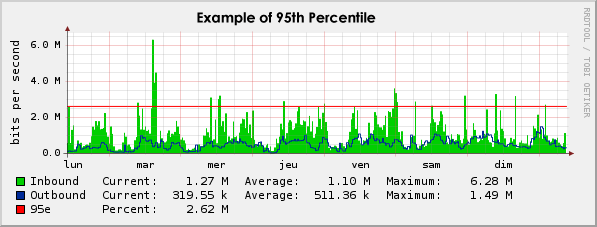95th Percentile Bandwidth Monitoring
95th percentile bandwidth monitoring is one of the most common ways to measure bandwidth. Instead of charging for the total traffic transferred (in GB) by a client each month, 95th percentile charges on a per-megabit rate (mbps). This rate is calculated by taking 5-minute transfer rate readings throughout the month, then removing the top 5% of these readings (i.e. usually most of the traffic spikes), and charging for the next highest rate of usage on the graph (95th%). This method is standard in the hosting industry because this is the way many of the colocation companies get charged for their bandwidth usage by major bandwidth suppliers.
It should be understood that two customers, each with a 1 mbps committed rate, could transfer completely different amounts of data. For example, if you burst at a very high mbps rate for 3 days in one month, and then use almost nothing the rest of the month you could have a high 95 percentile rate and only transfer 100 GB for the month. In another case you might be using 1 mbps (no bursts) at a steady rate for the entire 30 days and transfer close to 250 GB. If you sign up for 1 mbps and end up using 3 mbps for the month, then overage charges may apply. If you burst less than 5% of the time then these bursts will not be counted at all and you have little chance of going over your committed rate.

Per GB Transferred
If you are a low bandwidth user and can estimate how many GB per month you might transfer, then the pay-per-GB plan may be the best option for you. NetSource charges $0.10 per GB transferred per month. So at the end of the month if you transfer 30 GB your bandwidth bill will be $3. As you transfer more and more bandwidth the pay-per-GB plan becomes less attractive. For example, if you transfer 30 GB in a month your bandwidth bill will be $3.00. If you transferred 200GB your bill would be $20. A 1 mpbs connection would only cost $9 per month. About 9 out of 10 customers at NetSource are on the 95th% method of bandwidth billing.
